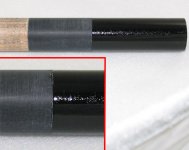Hi AZBers,
My name is Chad, and I am part of the team at Atlas Billiard Supplies. We are all sorry that you are having issues with the Double-Black® Linen tubing, but we may have an answer for you.
If you don’t mind first, a little history: Atlas developed the Double-Black® Linen tubing in conjunction with the Micarta Division of Westinghouse in the early 1990’s. The key was to have the white linen cloth dyed jet-black before being processed in a black resin system – hence the name “Double-Black”. This prevented white threads from showing through on the finished parts. Atlas then trademarked the term Double-Black® Linen.
Since that time, the Micarta Division was sold three different times and is no longer in existence. The other manufacturer that later developed this type of tubing material on its own, NVF Corp., is also now defunct. In addition, during the late 90’s and early 00’s, the phenolic business worldwide was going through great upheavals with plants closing and the prices of Benzene and other raw material stocks going through the roof.
We suffered along with the rest of you. However, we have spent a lot of time and money to get the formula back to where is used to be. We think we have reached that goal, and we have not heard many complaints outside of this forum.
Please take a look at the attached photo. I mounted a 6” segment of Double-Black® Linen tubing to a maple dowel. You can see that the left side is unfinished, and it does look as though there is some whiteness showing through. However, the right side has been coated with a simple acrylic finish, with no addition of ink, dyes, magic markers or anything else. The finish, as you can see, is jet black.
We are sure that each of you has your own special coating and finishing process that is much superior to a simple acrylic. Please go ahead and finish off some of the Double-Black® Linen tube with your own techniques, and see if you don’t get the same good result.
If you are still having problems, please call. We are here to try and help you, not make your craft more difficult. We are available by phone, email or PM me on AZB if you would like.
Thanks for your consideration.
Chad.



